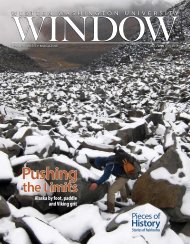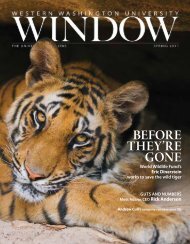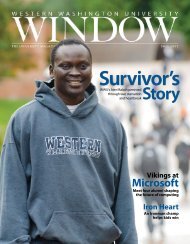WINDOW
Porch light groupies - WINDOW - The magazine for WWU
Porch light groupies - WINDOW - The magazine for WWU
- No tags were found...
Create successful ePaper yourself
Turn your PDF publications into a flip-book with our unique Google optimized e-Paper software.
The Soviets tried to<br />
force the Ket to learn<br />
Russian, herding<br />
Ket children into<br />
boarding schools.<br />
That, at least, is the<br />
opinion of Ed Vajda, a<br />
professor of Linguistics<br />
at Western Washington<br />
University, who several<br />
years ago excited<br />
anthropologists the world over with his hypothesis that these<br />
Siberian Ket people share their ancestry with many North<br />
Americans, including the Tlingit people of Southeast Alaska<br />
and the Navajo and Apache peoples of Arizona and New<br />
Mexico.<br />
That shared ancestry, Vajda believes, is revealed in the<br />
ways their languages overlap.<br />
In his studies of Ket and its linguistic brethren, for example,<br />
Vajda noticed that Yeniseian speakers combined the ideas<br />
of fire and water – using one word, “*igd,” for “down, into the<br />
open, toward water, toward fire,” and another word, “eqad <<br />
d∂q,” for “up, back, away from water, away from fire.” The Na-<br />
Dene languages also have directional words that conflate water<br />
and fire. And not only that, their words “‘i’x-d” and “dá’G<br />
*d∂G” appear to share a common etymological origin.<br />
Other words, such as those for mosquito, wolverine, river,<br />
navel, head, finger and conifer needle, also are similar, Vajda<br />
says. The ancient Ket pronounced the word for mosquito (sūj)<br />
“soo-ee,” he says, while Na-Dene speakers say “tsoo-ee.”<br />
The more he stumbled on such linguistic similarities, the<br />
more Vajda realized they couldn’t be explained away by happenstance.<br />
To date, his research has revealed 100-or-so such<br />
shared words.<br />
Kets are sturdy survivors<br />
Ket is the last surviving member of the once robust Yeniseian<br />
language family. Now extinct are Yugh, Kott, Assan, Arin and<br />
Pumpokol, among others, all of whose speakers lived further<br />
south along the Yenisei River, toward Mongolia and civilization.<br />
Only the northernmost Ket people, formerly called the<br />
Yenisei Ostyak – from a word that the early Russians applied<br />
to all west Siberian forest people – survived into the 20th<br />
century. (The Ket take their present name from their tribe’s<br />
word for “person.”)<br />
And Ket is dwindling fast. Fewer than 50 people – and all<br />
of them older than 55 – speak any of the three Ket dialects<br />
fluently. The elders still teach Ket to youngsters in several<br />
small villages, including Kellog, but most Kets speak Russian<br />
and at best know only a few Ket words.<br />
Vajda, who expects the language to disappear as a natural<br />
means of communication once today’s elders are gone, traces<br />
the language’s demise to the 1930s and ’40s, when the nomadic<br />
Ket people were forced by Soviet collectivization campaigns<br />
to settle into villages. The Soviets tried to force the Ket<br />
and other non-Russian speakers to learn Russian, even going<br />
so far as to herd their children into boarding schools.<br />
Over time, Ket was heard less and less along the river.<br />
“Now, you absolutely can’t get along without Russian in<br />
these areas, whether you’re Ket or not,” Vajda says.<br />
Two of Vajda’s best current sources for the Ket language,<br />
Marina Irikova and Pavel Sutlin (known in Ket as “Dumgit”,<br />
meaning “Little Bird”), know Ket only because they ran away<br />
from their boarding schools as young children in the 1950s.<br />
They hid in the Siberian Taiga – the Earth’s largest forest –<br />
for days and returned to their people only when the Soviets<br />
stopped looking. Vajda has worked most extensively with<br />
Valentina Romanenkova, a fully fluent speaker who communicates<br />
daily with her mother, who is now in her eighties.<br />
A ‘last living link’<br />
Worldwide, one language disappears every two weeks. But<br />
the loss of Ket is more than the loss of just another language,<br />
Vajda says.<br />
Ket speakers were the last hunter-gatherers north of the<br />
south Siberian steppes, only abandoning their mobile lifestyle<br />
during the ’30s. They raised no animals for food, subsisting<br />
instead on hunting, fishing and the gathering of wild plants.<br />
They lived among early reindeer-breeding pastoral people,<br />
such as Turks, Mongols and Samoyeds, contributing words to<br />
their language families, too.<br />
“The words tell us something about prehistoric interaction<br />
between peoples in the region between the steppes and the<br />
forest,” Vajda says. “Losing Ket as a living language means<br />
losing the last living link in this ancient record. Without language<br />
documentation, it would be lost forever.”<br />
The Ket can thank their hordes of mosquitos for helping<br />
to preserve their language and culture, Vajda says. The mosquito<br />
infestation was so bad in summer that the Ket spent the<br />
warmer months living on houseboats in the river. The pests<br />
made reindeer breeding difficult and discouraged visitors<br />
from staying long.<br />
The Ket language, with its prefixing verb structure, is built<br />
differently than Turkic, Mongolian and Samoyed, the languages<br />
that surrounded it for thousands of years. As such, Ket<br />
has adapted itself over the years in ways no other language in<br />
human history has had to do, Vajda says.<br />
“Ket is really interesting to study for understanding human<br />
language diversity and how languages can contact and<br />
influence each other over time,” he says.<br />
He’s at work on a comprehensive dictionary of all Yeniseian<br />
languages, fighting against time to preserve all that can be known<br />
about the language structures, verbs, tones and vocabularies.<br />
Not only is Ket the last window into the human prehistory<br />
of North Asia, Vajda says, it’s also a key to understanding<br />
the peopling of the Americas. By studying Ket and changes<br />
to the surrounding languages, Vajda believes he can paint a<br />
The more Vajda<br />
stumbled on linguistic<br />
similarities, the more<br />
he realized they<br />
couldn’t be explained<br />
by happenstance.<br />
historical picture, starting<br />
as far back as the last ice<br />
age, of the movements<br />
of people throughout<br />
north Asia and across the<br />
Bering Strait into North<br />
America.<br />
It has long been supposed that these two peoples were<br />
linked by language, but Vajda’s work is the first to gain widespread<br />
acceptance among scholars.<br />
His hypothesis relies heavily on the studies of Germany’s<br />
Heinrich Werner, who worked with the Kets and Yughs (relatives<br />
of the Ket who went extinct in the 1980s) for more than<br />
30 years. Vajda also has stood on the shoulders of Russia’s<br />
Andreas Dulzon, who began modern fieldwork with the Ket<br />
language in 1955 and continued until his death in 1973.<br />
More recently, Vajda has collaborated with historical<br />
linguist George Starostin, of Moscow, and with Germany’s<br />
Stefan Georg, who in 2000 became the first person from<br />
outside Russia to conduct original fieldwork among the Kets,<br />
and who has written a robust Ket grammar.<br />
He spent part of fall 2012 studying with Bernard Comrie<br />
at the Max Planck Institute for Evolutionary Biology, looking<br />
for further evidence of relationships among the Yeniseian and<br />
Na-Dene languages.<br />
Part of the reason that Vajda’s Dene-Yeniseian hypothesis<br />
has gained steam among researchers is that since publicizing<br />
his ideas, Vajda has gathered information from other realms<br />
of research – including archaeology, genetics and cultural<br />
heritage studies – to show that such a connection is not only<br />
possible but probable.<br />
Hints in ‘living memory’<br />
Vajda’s hypothesis has not gone unnoticed by the Na-Dene<br />
people of North America.<br />
“Elders tell me that often too little attention has been<br />
paid by linguists and anthropologists to traditional folk belief,<br />
to the living memory of the people,” Vajda says. “I think<br />
they’re right.”<br />
As he studies further links between these peoples, Vajda<br />
hopes to learn migration stories from various Na-Dene tribes<br />
in North America.<br />
“I suspect they preserve ancient memory of real events,”<br />
he says.<br />
Vajda says he’s heard enough folklore to intrigue him, including<br />
vague stories of ancestral migration over water. One<br />
such story even says that dogs could be heard barking from<br />
the water during one over-water trip, and some historians<br />
have interpreted the barking to be that of seals.<br />
But none of the stories is clear enough to contain any<br />
sort of proof of an ancient migration across the Bering Strait,<br />
Edward Vajda spent several weeks in northern Siberia documenting the Ket language<br />
in Kellog Village, which sits along the Yelogui River. Above, Vajda walks<br />
down Kellog's main street with Valentina, whose mother, Ulka, is a perfect<br />
speaker of Ket. Valentina, below, and her mother are crucial to Vajda's research.<br />
Vajda says.<br />
“There are some hints in some stories that could be interpreted<br />
in that way,” he says, “but they could be interpreted in<br />
other ways, too.”<br />
And that’s a problem that can only be settled by further research,<br />
Vajda says. After he’s done cataloguing for posterity all<br />
he knows of the Yeniseian languages, he’ll renew his hunt for<br />
ways – whether they be linguistic, cultural, spiritual or genetic<br />
– that these people from different continents are linked.<br />
“There needs to be a lot more research on various aspects of<br />
the connection,” he says, “in order for the issue to be settled.”<br />
Matthew Anderson (’06, Journalism) is Western’s New Media<br />
coordinator. His previous stories for Window include a profile of<br />
Vehicle Research Institute students building a 100-mpg car for the<br />
Progressive Automotive X-PRIZE. His other writing, in 140-character<br />
increments, can be found on Western’s Twitter feed.<br />
16 <strong>WINDOW</strong> • Fall/Winter 2012 • Western Washington University www.wwu.edu/window 17








